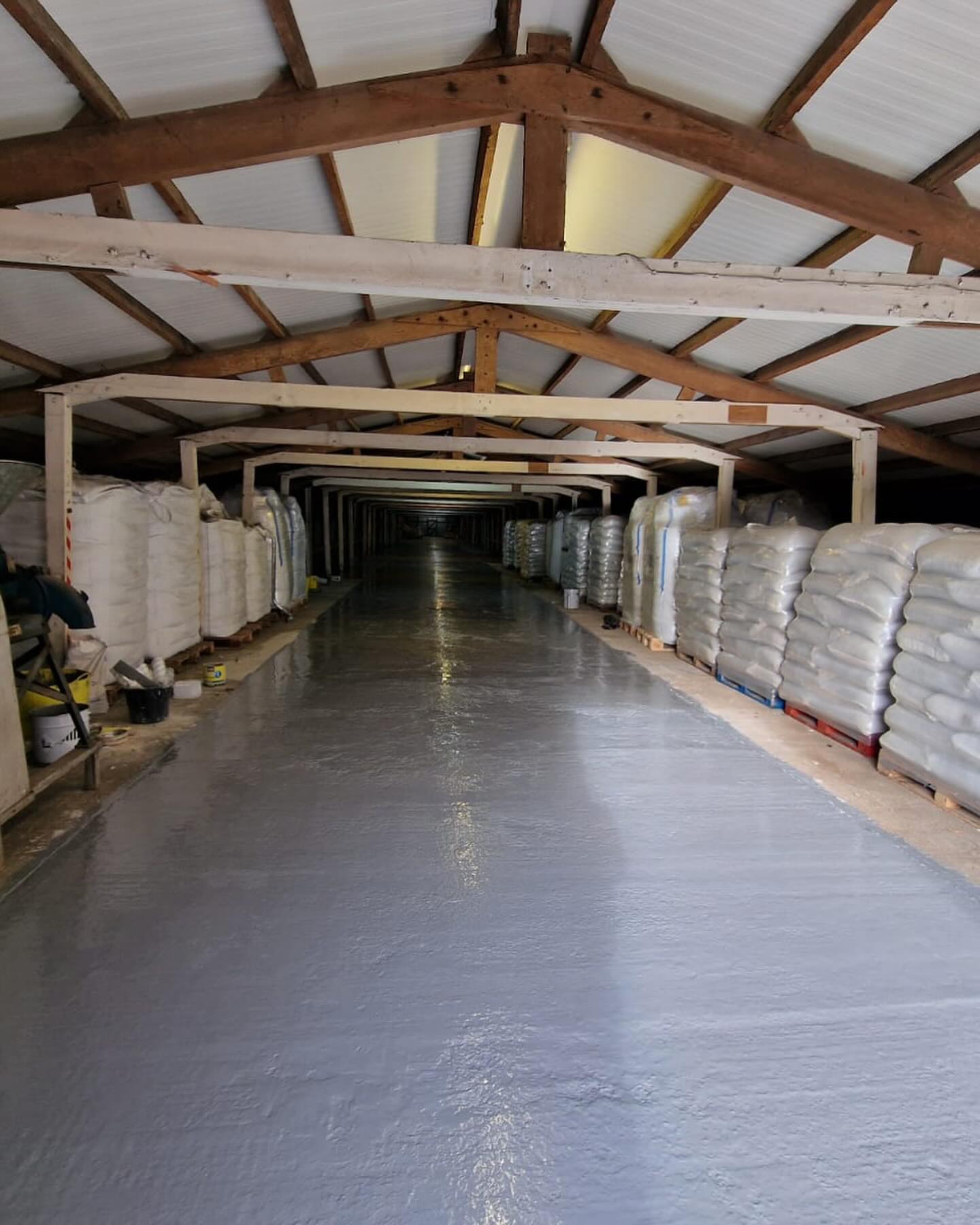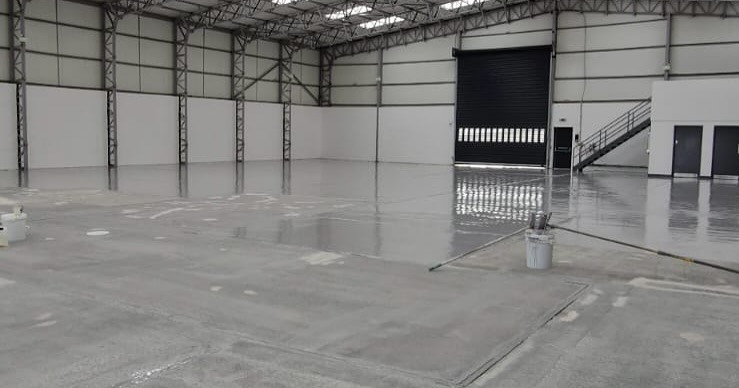Epoxy flooring costs £11-15 per m² and provides superior chemical resistance, customizable colours, and a sealed surface ideal for hygiene-critical environments. Polished concrete costs £11-15 per m², offers a natural aesthetic, and requires less maintenance but provides limited chemical protection and cannot be colored after installation.
When upgrading warehouse or industrial floors, the choice between epoxy coatings and mechanically polished concrete represents a fundamental decision about performance priorities and long-term value. Both systems transform raw concrete into durable working surfaces, but through entirely different processes. Having installed both systems across hundreds of London facilities, we'll break down the real differences that matter for your operation.
What's the Real Cost Difference?
Initial installation costs tell only part of the story. While polished concrete appears cheaper upfront, the total cost of ownership depends heavily on your specific operational requirements:
| Cost Factor | Epoxy Flooring | Polished Concrete |
|---|---|---|
| Initial Installation | £11-15 per m² | £11-15 per m² |
| Preparation Required | Diamond grinding | Multiple grinding passes |
| Installation Time (1000m²) | 3-5 days | 5-7 days |
| Annual Maintenance | £11-15 per m² | £0.50-1 per m² |
| Recoat/Refresh Cycle | 5-7 years | Re-densify every 3-5 years |
| 20-Year Total Cost | £11-15 per m² | £11-15 per m² |
The concrete grinding services required for both options represent a significant portion of installation costs. However, polished concrete requires multiple progressive grinding stages to achieve the desired sheen level, while epoxy preparation typically needs only a single grinding pass.
How Long Does Each System Last?
Epoxy flooring systems provide a protective layer over concrete, typically lasting 10-15 years in moderate traffic areas and 5-10 years under heavy industrial use. The coating acts as a sacrificial wear layer, protecting the substrate while taking the brunt of daily abuse from forklift traffic, chemical spills, and impact damage.
Burnished and polished concrete doesn't wear out in the traditional sense - it's the concrete itself that becomes the wearing surface. With proper maintenance and periodic re-densification, polished concrete can last 20+ years. However, it's susceptible to staining, etching from acids, and micro-fracturing under heavy point loads.

Daily Maintenance Requirements
Epoxy floors require regular cleaning with neutral pH cleaners to maintain their appearance and prevent build-up of contaminants. The non-porous surface makes cleaning straightforward - spills stay on the surface and can be quickly removed. However, the glossy finish shows scratches and wear patterns more readily, particularly in high-traffic lanes.
Polished concrete maintenance involves daily dust mopping to prevent abrasive particles from dulling the surface, followed by auto-scrubbing with specialized cleaners that don't strip the densifier. While day-to-day cleaning is simple, removing stains from polished concrete can be challenging since contaminants can penetrate the porous surface despite densification treatments.
Aesthetic Options and Limitations
Epoxy offers unlimited colour options, from solid RAL colours to decorative flake systems and even metallic finishes. You can incorporate company colours, safety demarcation lines, and walkway markings directly into the floor system. The surface can be finished from high-gloss to matte, depending on slip resistance requirements.
Polished concrete provides a natural stone appearance with the existing concrete's aggregate exposure determining the final look. While you can't change colours after installation, different levels of aggregate exposure (cream polish, salt-and-pepper, or full aggregate) create distinct aesthetics. The reflective surface enhances lighting but limits design flexibility.
Need Help Choosing the Right Floor System?
Our flooring experts provide free consultations to assess your facility and recommend the most cost-effective solution for your specific needs.
Book Your Free ConsultationChemical and Stain Resistance
Epoxy creates an impermeable barrier that resists most chemicals, oils, and stains. This makes it ideal for pharmaceutical flooring, laboratories, and manufacturing plants where chemical exposure is routine. Spills remain on the surface for easy cleanup without penetrating the substrate.
Polished concrete, despite densification treatments, remains somewhat porous. While it resists water and light oils, acids, wines, and other staining agents can permanently mark the surface. Chemical spills require immediate attention to prevent etching or staining, making it less suitable for environments with regular chemical exposure.
Installation Process and Disruption
Epoxy installation follows a systematic process:
- Surface preparation via grinding (1 day)
- Crack and joint repairs
- Primer application
- Base coat application (1-2mm typical)
- Optional broadcast layer for texture
- Seal coat application
- 24-48 hour cure before traffic
Polished concrete requires a more intensive process:
- Initial grinding with metal-bond diamonds (30-40 grit)
- Progressive grinding (80, 150, 400 grit)
- Densifier application between grits
- Polishing stages (800, 1500, 3000 grit)
- Final burnishing for maximum shine
- Immediate traffic upon completion

Which System for Which Application?
Choose Epoxy Flooring For:
- Warehouse flooring requiring colour coding
- Food production areas needing hygiene compliance
- Chemical storage and processing areas
- Wet process areas requiring seamless surfaces
- Facilities needing anti-slip flooring systems
- Areas requiring ESD protection
Choose Polished Concrete For:
- Dry warehouse storage areas
- Retail showrooms and public spaces
- Distribution centres with high lighting costs
- Facilities prioritizing sustainability
- Areas where natural aesthetics are valued
- Budgets favouring lower maintenance costs
Making the Right Choice for Your Facility
For most industrial applications where chemical resistance, hygiene, and customization matter, epoxy flooring provides superior performance despite higher initial costs. The ability to incorporate safety markings, withstand chemical exposure, and provide a completely sealed surface makes it the practical choice for active industrial environments.
Polished concrete excels in large, dry storage facilities where the natural aesthetic is appreciated and chemical exposure is minimal. The lower maintenance requirements and enhanced light reflectivity can provide significant operational savings in the right environment.
Consider a hybrid approach: polished concrete in general warehouse areas with epoxy coatings in production zones, loading bays, and chemical storage areas. This strategy, common in modern distribution centres, optimizes both cost and performance across different operational zones.
For specific guidance on your flooring decision, explore our surface preparation comparison or learn about advanced options like fast-cure coating systems.
Ready to Transform Your Industrial Floor?
Get detailed quotes for both epoxy and polished concrete options. We'll help you choose the most cost-effective solution for your specific operational requirements.
Get Your Free Quote